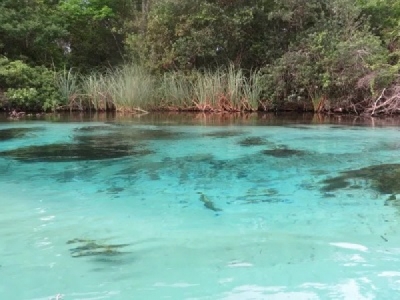
Posted on November 16, 2018
During a public workshop last week, Hernando County Commissioner John Allocco examined an aerial photo of the Weeki Wachee River — from it spring-fed source to just past Rogers Park.
It provided a clear look at the various areas the river passes through, from pristine and undeveloped to filled with waterfront homes and businesses. Along the run were yellow markers where sampling is underway.
Allocco, who has taken a lead among elected county officials on the contentious issue of river overcrowding, wanted to know how the county’s money is being spent to quantify the problem.
James Fine, the Southwest Florida Water Management District’s project manager, explained to Allocco and Commissioner John Mitten how his agency is overseeing the Weeki Wachee River carrying-capacity study.
The county and management district are funding the $250,000 study, seen as a first step in understanding overuse issues and the precursor to an expected $6 million restoration project spearheaded by state Sen. Wilton Simpson, R-Trilby.
“At the end of the day, you’ll know what’s going on down here,” Fine told commissioners. “You’ll have the science.”
Allocco nodded. “Then we’ll be able to make our decisions,” he said.
The study started in May and results are expected late next year. The work is as complex as the issues facing the myriad agencies and policy setters who must find solutions.
Previous coverage: State reduces kayak launches into Weeki Wachee River
The public workshop drew local residents concerned about kayak overcrowding and shoreline destruction. Also represented were the many jurisdictions working to protect the river, yet allow public access.
The study examines the waters within the Weeki Wachee Springs State Park at the river’s source, the middle areas of the waterway and the tidally-influenced section as the river empties into the Gulf of Mexico.
The independent consultant, Wood Environment and Infrastructure Solutions, is looking at erosion along the riverbanks. Some is attributed to people running kayaks and other boats onto the shorelines or climbing onto the banks.
Researchers can quantify scars from boat propellers and damage from people trampling vegetation, eroding shorelines and dumping trash.
Cameras set in four locations along the river take time-lapsed footage every five seconds from 8 a.m. to 4 p.m. The photos allow researchers to count users, and chart vessel types, direction of travel and the behavior of participants. In addition, user surveys are underway.
“People love being on the river, and they love seeing the wildlife on the river, but they say there are too many people, and that makes the experience less enjoyable,” said Kristen Nowak. She is conducting in-person interviews with river users for the project.
Fine said the surveys are an important part of the study.
“We want to get a flavor of how people are thinking,” he said.
The study will include water-quality sampling and examination of the sediment. The latter has been a concern because sand piling up on the river bottom has blocked safe navigation and increased conflicts between paddle-powered and motor-powered craft. River dredging to deepen the waterway could be part of the proposed restoration.
One thing the study won’t do is set limits on use of the river. The study will provide information to the agencies that oversee and regulate public usage.
Last week’s workshop brought together law enforcement officers with the Fish and Wildlife Conservation Commission and the Hernando County Sheriff’s Office, along with officials from the water management district and the county who may have to make zoning decisions for land along the river.
Fine said he was encouraged by the level of cooperation among the groups, and noted that the Florida Department of Environmental Protection has provided in-kind support for the study.
“We’re the engineers and the scientists,” Fine said, “and what we produce, they will be able to use as a tool.”
Source: Tampa Bay Times





